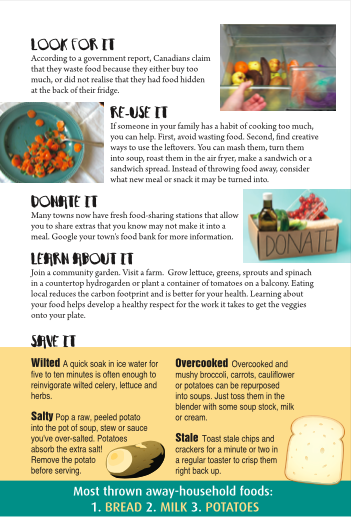
North Americans create approximately 2 billion tons of garbage per year. We can help change that!
LOOK FOR IT
According to a government report, Canadians claim that they waste food because they either buy too much, or did not realize that they had food hidden in the back of their fridge.
RE-USE IT
If someone in your family has a habit of cooking too much, you can help. First, avoid wasting food. Second, find creative ways to use the leftovers. You can mash them, turn them into soup, roast them in the air-fryer, make a sandwich or a sandwich spread. Instead of throwing food away, consider what a new meal or snack it may be turned into.
DONATE IT
Many towns now have fresh food-sharing stations that allow you to share extras that you know may not make it into a meal. Google your town’s food bank for more information.
LEARN ABOUT IT
Join a community garden. Visit a farm. Grow lettuce, greens, sprouts, and spinach in a countertop hydrogarden or plant a container of tomatoes on a balcony. Eating local reduces the carbon footprint and is better for your health. Learning about your food helps develop a healthy respect for the work it takes to get the veggies onto your plate.
SAVE IT
| WILTED | A quick soak in ice water for five to ten minutes is often enough to reinvigorate wilted celery, lettuce, and herbs. |
| OVERCOOKED | Overcooked and mushy broccoli, carrots, cauliflower or potatoes can be repurposed into soups. Just toss them in the blender with some soup stock, milk, or cream. |
| SALTY | Pop a raw, peeled potato into a pot of soup, stew or sauce you’ve over-salted. Potatoes absorb the extra salt! Remove the potato before serving. |
| STALE | Toast stale chips and crackers for a minute or two in a regular toaster to crisp them right back up. |
| MOST THROW-AWAY | Bread, milk, potatoes |


